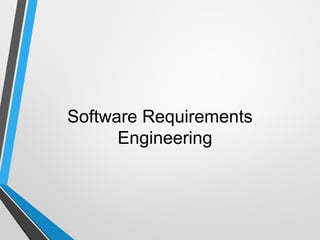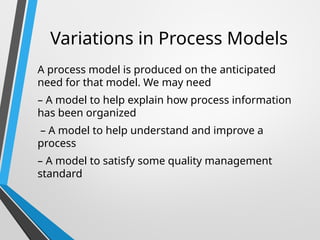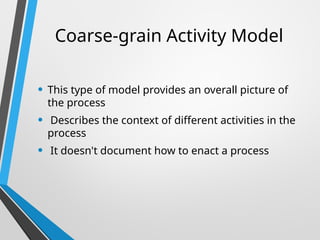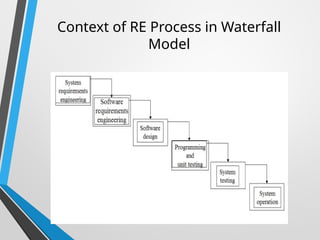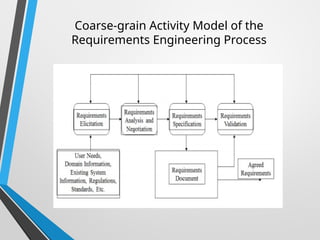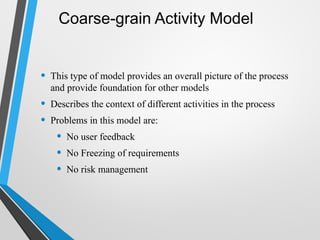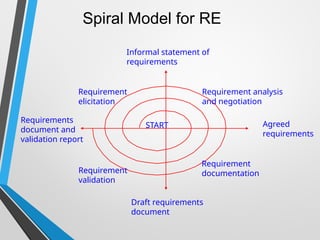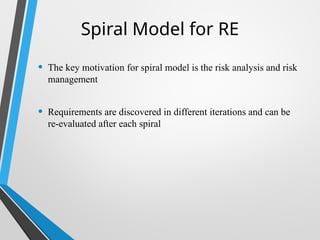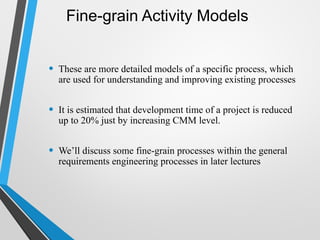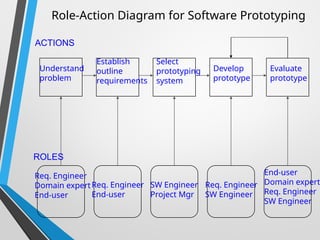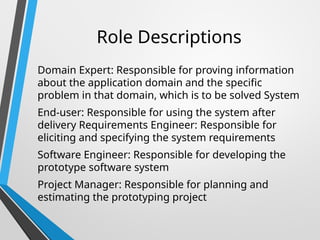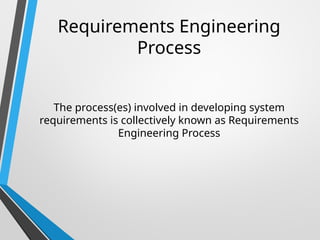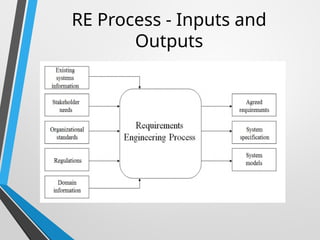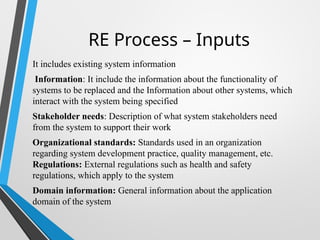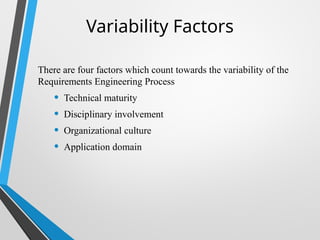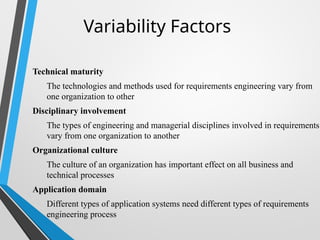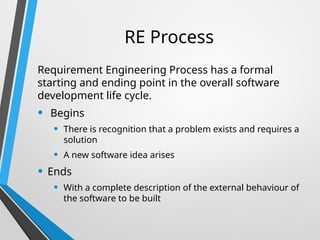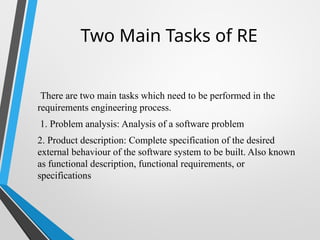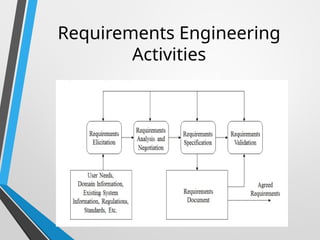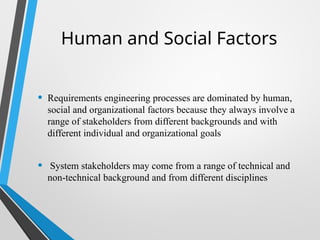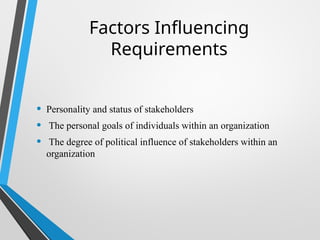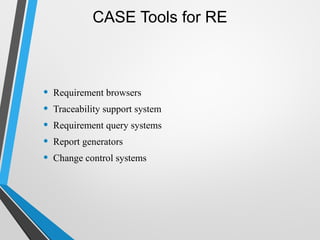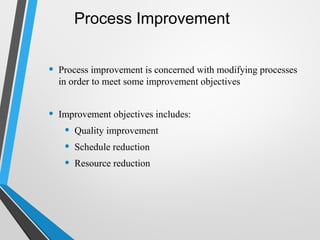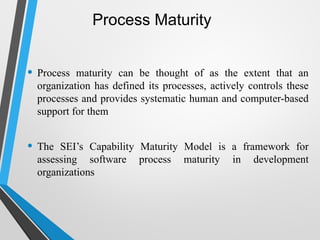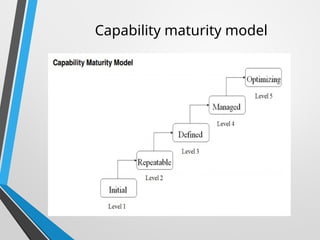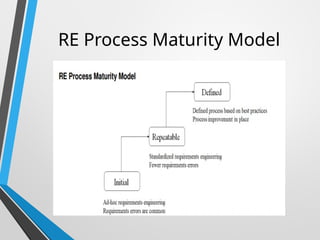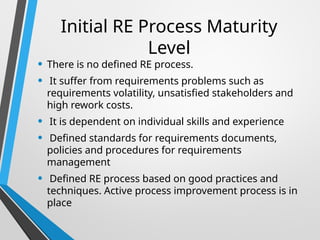Lecture2_REQUIREMENT_Process__Modelss.pptx
- 2. Process ŌĆó A process is an organized set of activities, which transforms inputs to outputs ŌĆó Processes are essential for dealing with complexity in real world ŌĆó Processes document the steps in solving a certain problem ŌĆó They allow knowledge to be reused ŌĆó Examples: ŌĆó An instruction manual for assembling a computer or its parts ŌĆó A procedure manual for operating a motor vehicle radio and CD player
- 3. Software Process ŌĆó Software processes help in performing different software engineering activities in an organized manner ŌĆó Examples: ŌĆó Software engineering development process (SDLC) ŌĆó Requirements engineering process ŌĆó Design process ŌĆó Quality assurance process ŌĆó Change management process
- 4. Process Models ŌĆó A process model is a simplified description of a process presented from a particular perspective ŌĆó There may be several different models of the same process ŌĆó No single model gives a complete understanding of the process being modelled
- 5. Variations in Process Models A process model is produced on the anticipated need for that model. We may need ŌĆō A model to help explain how process information has been organized ŌĆō A model to help understand and improve a process ŌĆō A model to satisfy some quality management standard
- 6. Types of Process Model ŌĆó Coarse-grain activity models ŌĆó Fine-grain activity models ŌĆó Role-action models ŌĆó Entity-relation models
- 7. Coarse-grain Activity Model ŌĆó This type of model provides an overall picture of the process ŌĆó Describes the context of different activities in the process ŌĆó It doesn't document how to enact a process
- 8. Context of Requirements Engineering ŌĆó Software requirements follow the ŌĆ£system requirementsŌĆØ and ŌĆ£system designŌĆØ ŌĆó The primary goal is understanding ŌĆó Software requirements are followed by software design in a software development life cycle
- 9. Context of RE Process in Waterfall Model
- 10. Another Perspective on Context of RE Process
- 11. Coarse-grain Activity Model of the Requirements Engineering Process
- 12. Coarse-grain Activity Model ŌĆó This type of model provides an overall picture of the process and provide foundation for other models ŌĆó Describes the context of different activities in the process ŌĆó Problems in this model are: ŌĆó No user feedback ŌĆó No Freezing of requirements ŌĆó No risk management
- 13. Spiral Model for RE Informal statement of requirements Draft requirements document Requirements document and validation report Agreed requirements START Requirement elicitation Requirement analysis and negotiation Requirement validation Requirement documentation
- 14. Spiral Model for RE ŌĆó The key motivation for spiral model is the risk analysis and risk management ŌĆó Requirements are discovered in different iterations and can be re-evaluated after each spiral
- 15. Fine-grain Activity Models ŌĆó These are more detailed models of a specific process, which are used for understanding and improving existing processes ŌĆó It is estimated that development time of a project is reduced up to 20% just by increasing CMM level. ŌĆó WeŌĆÖll discuss some fine-grain processes within the general requirements engineering processes in later lectures
- 16. Role-action Models ŌĆó These are models, which show the roles of different people involved in the process and the actions which they take ŌĆó They are useful for process understanding and automation ŌĆó Example: Stakeholders model for organization
- 17. Role-Action Diagram for Software Prototyping Understand problem Establish outline requirements Select prototyping system Develop prototype Evaluate prototype Req. Engineer Domain expert End-user Req. Engineer End-user SW Engineer Project Mgr Req. Engineer SW Engineer End-user Domain expert Req. Engineer SW Engineer ACTIONS ROLES
- 18. Role Descriptions Domain Expert: Responsible for proving information about the application domain and the specific problem in that domain, which is to be solved System End-user: Responsible for using the system after delivery Requirements Engineer: Responsible for eliciting and specifying the system requirements Software Engineer: Responsible for developing the prototype software system Project Manager: Responsible for planning and estimating the prototyping project
- 19. Entity-relation Models ŌĆó The models show the process inputs, outputs, and intermediate results and the relationships between them ŌĆó They are useful in quality management systems
- 20. Requirements Engineering Process The process(es) involved in developing system requirements is collectively known as Requirements Engineering Process
- 21. RE Process - Inputs and Outputs
- 22. RE Process ŌĆō Inputs It includes existing system information Information: It include the information about the functionality of systems to be replaced and the Information about other systems, which interact with the system being specified Stakeholder needs: Description of what system stakeholders need from the system to support their work Organizational standards: Standards used in an organization regarding system development practice, quality management, etc. Regulations: External regulations such as health and safety regulations, which apply to the system Domain information: General information about the application domain of the system
- 23. RE Process ŌĆō Inputs Agreed requirements: A description of the system requirements, which is understandable by stakeholders and which has been agreed by them System specification: This is a more detailed specification of the system, which may be produced in some cases System models: A set of models such as a data-flow model, an object model, a process model, etc., which describes the system from different perspectives
- 24. RE Process Variability ŌĆó RE processes vary radically from one organization to another, and even within an organization in different projects ŌĆó Unstructured processes rely heavily on the experience of the people, while systematic processes are based on application of some analysis methodology, but they still require human judgment
- 25. Variability Factors There are four factors which count towards the variability of the Requirements Engineering Process ŌĆó Technical maturity ŌĆó Disciplinary involvement ŌĆó Organizational culture ŌĆó Application domain
- 26. Variability Factors Technical maturity The technologies and methods used for requirements engineering vary from one organization to other Disciplinary involvement The types of engineering and managerial disciplines involved in requirements vary from one organization to another Organizational culture The culture of an organization has important effect on all business and technical processes Application domain Different types of application systems need different types of requirements engineering process
- 27. RE Process Requirement Engineering Process has a formal starting and ending point in the overall software development life cycle. ŌĆó Begins ŌĆó There is recognition that a problem exists and requires a solution ŌĆó A new software idea arises ŌĆó Ends ŌĆó With a complete description of the external behaviour of the software to be built
- 28. Two Main Tasks of RE There are two main tasks which need to be performed in the requirements engineering process. 1. Problem analysis: Analysis of a software problem 2. Product description: Complete specification of the desired external behaviour of the software system to be built. Also known as functional description, functional requirements, or specifications
- 30. Human and Social Factors ŌĆó Requirements engineering processes are dominated by human, social and organizational factors because they always involve a range of stakeholders from different backgrounds and with different individual and organizational goals ŌĆó System stakeholders may come from a range of technical and non-technical background and from different disciplines
- 31. Factors Influencing Requirements ŌĆó Personality and status of stakeholders ŌĆó The personal goals of individuals within an organization ŌĆó The degree of political influence of stakeholders within an organization
- 32. RE Process Support ŌĆó One way to minimize errors in the requirements engineering is to use process models and to use CASE tools ŌĆó The most mature CASE tools support well-understood activities such as programming and testing and the use of structured methods ŌĆó Support for requirements engineering is still limited because of the informality and the variability of the process
- 33. CASE Tools for RE ŌĆó Requirement browsers ŌĆó Traceability support system ŌĆó Requirement query systems ŌĆó Report generators ŌĆó Change control systems
- 34. Process Improvement ŌĆó Process improvement is concerned with modifying processes in order to meet some improvement objectives ŌĆó Improvement objectives includes: ŌĆó Quality improvement ŌĆó Schedule reduction ŌĆó Resource reduction
- 35. RE Process Problems ŌĆó Lack of stakeholders involvement ŌĆó Business needs not considered ŌĆó Lack of requirements management ŌĆó Lack of defined responsibilities ŌĆó Stakeholders communication problems ŌĆó Gold-plating ŌĆó Over-long schedules and poor quality requirements documents
- 36. Process Maturity ŌĆó Process maturity can be thought of as the extent that an organization has defined its processes, actively controls these processes and provides systematic human and computer-based support for them ŌĆó The SEIŌĆÖs Capability Maturity Model is a framework for assessing software process maturity in development organizations
- 38. RE Process Maturity Model
- 39. Initial RE Process Maturity Level ŌĆó There is no defined RE process. ŌĆó It suffer from requirements problems such as requirements volatility, unsatisfied stakeholders and high rework costs. ŌĆó It is dependent on individual skills and experience ŌĆó Defined standards for requirements documents, policies and procedures for requirements management ŌĆó Defined RE process based on good practices and techniques. Active process improvement process is in place
